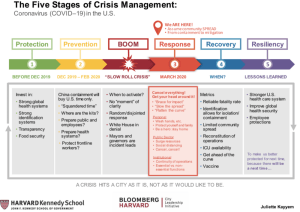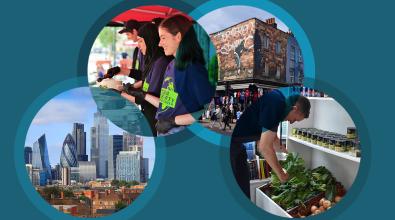Finding your footing in a ‘slow roll’ crisis

For most mayors, the rapidly evolving events of the past two weeks have made this their most trying and disorienting time in office. Even veterans of floods, tornadoes, and hurricanes have struggled to make sense of the Covid-19 crisis. This is a disaster that lacks a clear beginning or end, one where mayors are forced to make some of the hardest decisions of their lives long before most of their constituents have felt any impact at all.
Juliette Kayyem says Covid-19 is an example of a “slow roll” crisis. Addressing U.S. mayors in the opening session of the Coronavirus Local Response Initiative last week, the Harvard University professor counseled local leaders to “give yourself a chance to recognize how bizarre this is.” Kayyem herself knew exactly what pandemic planning and “social distancing” measures would look like, she said, and even she “found the last couple of days jarring, how quickly it happened.”
Her talk with mayors focused largely on helping orient them in terms of where they stand right now in the typical five stages of crisis management. “While the virus is new, crisis management is not,” she said. “It actually is beginning to look familiar, and that should give you some hope — it’s not all chaos.”
The graphic above shows the stages, along with dates associated with each from a United States perspective.
The first stage — protection — came before the novel coronavirus emerged in China in December. That’s the period where, in an ideal world, we would have built strong health systems, both nationally and globally, to respond to a pandemic. That time has passed.
The second stage — prevention — also has passed. That’s the period after the virus emerged in China, when preparations in the U.S. could ramp up so that health systems, political leaders, and the public would be ready for it. “The history books will probably write this period as squandered time,” Kayyem said. “It’s the period when we probably should have been thinking about getting and distributing more test kits and preparing all of you for the choices you were going to have to make.”
Then came the “boom” — the messy days when it rapidly became clear that Covid-19 was turning into a crisis. The challenge, Kayyem said, is that this moment looked differently in Seattle or New York City than it did in locations without any infections yet. “The challenge of the ‘slow-roll’ boom is when do you activate, as a mayor?” Kayyem said. “I can’t answer that for you,” she continued. “All I know is that tomorrow is too late.”
The third stage is where most mayors are today — response. They’re canceling events, urging the public to heed warnings, implementing telework plans, and preparing hospitals for a surge of patients. We’re still at the beginning of the response stage, Kayyem said, and it will be a fluid situation for some time.
It’s too early to say when the final two stages will arrive. The next one — recovery — will be the time when things look and feel like they are returning to normal. It’s when spread of the virus is contained, the health system has capacity to handle severe cases, and ultimately, when a vaccine arrives. Finally will come the resiliency stage. That’s when this whole episode is behind us — and we can, hopefully, apply lessons learned toward building a stronger health system going forward.
“If I could give you any advice,” Kayyem said, “It’s this: A crisis comes to a city as it is, not how you wish it to be.” Mayors may be particularly unhappy right now with the state of their city’s health infrastructure or inequalities in their communities, she said, and Covid-19 “is going to exacerbate all the things that you hate about that inequality. Unfortunately, you’ve got to get through the response first. It’s not going to get fixed through this …. Keep your eyes on the prize. Get your community to recovery. And then we have those debates.”


